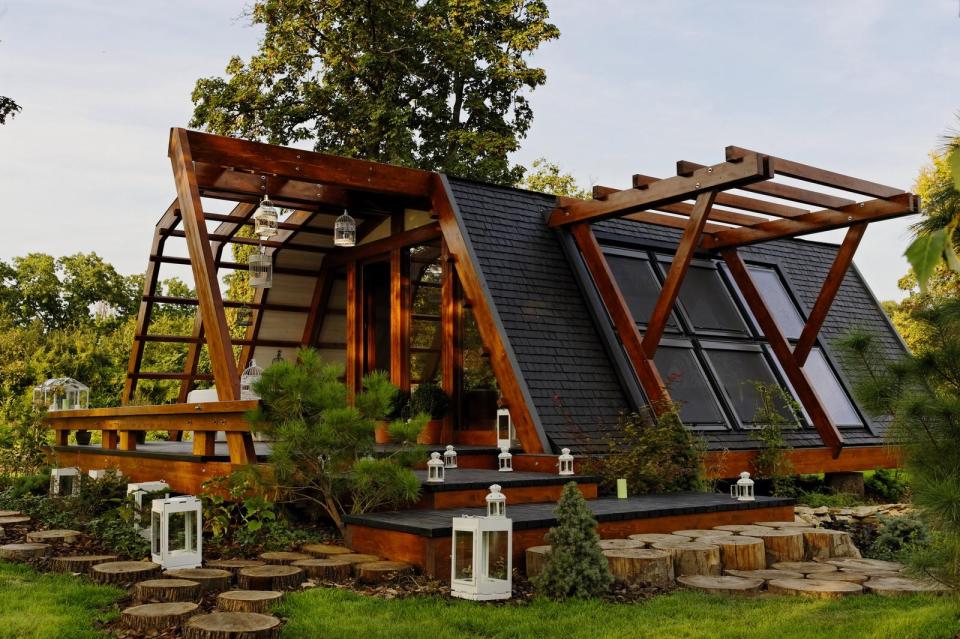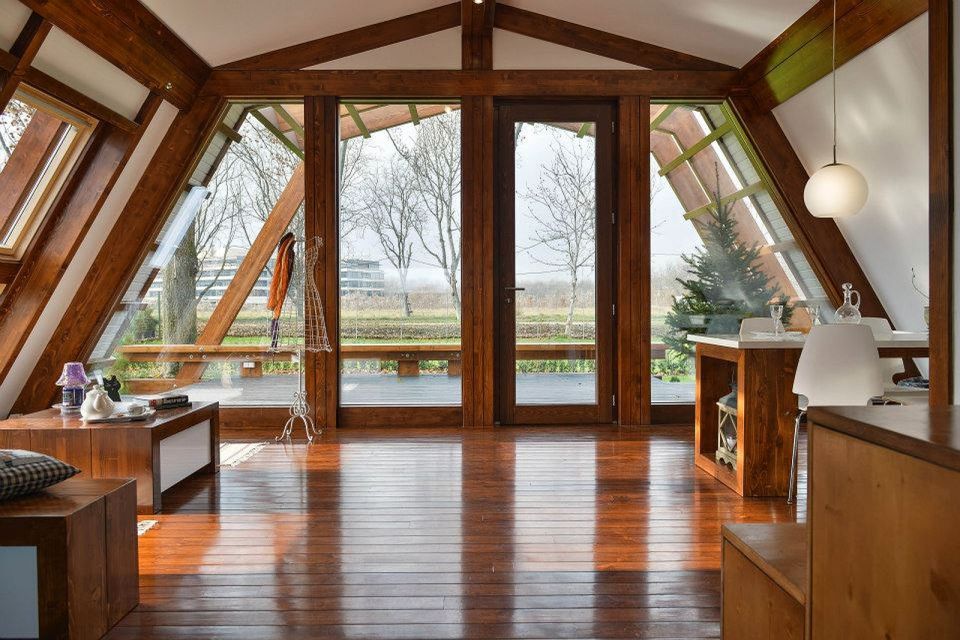The Soleta zeroEnergy One

The Soleta zeroEnergy is a new family of modular eco-friendly houses by the Justin Capra Foundation for Inventions and Sustainable Technologies (FITS) in Romania. FITS set out to design flexible homes that would be affordable, both in terms of the initial purchase price and ongoing operating costs. The houses combine proven, practical strategies with leading edge technologies. Shown here is a prototype of the Soleta zeroEnergy One, the smallest home in the lineup.
The Soleta zeroEnergy has an unusual gambrel roof design that is more commonly associated with farm buildings and airplane hangars than houses. But unlike those utilitarian structures, the zeroEnergy One is covered in wood shingles, has huge windows on the side and gable end, and has massive wood pergolas shading those windows.

The somewhat utilitarian appearance notwithstanding, the zeroEnergy One looks to be quite cozy inside, with exposed beams and wood finishes. The glue-laminated wood support arches leave the interior free of bearing walls or columns. The ground floor is 48 m2 (517 ft2), though the usable area will be slightly less due to the sloping sidewalls. Upstairs (with the stairs being a set of giant steps that double as storage cabinets) is a 9 m2 (97 ft2) lofted bedroom.

The FITS team hopes that purchasers will pair the zeroEnergy homes with some form of renewable energy system in order to actually achieve net zero energy use on an annual basis. However, even if one is hooked up to standard utility services, it will still use those services sparingly. Large high-performance windows make good use of available daylight for illumination, and when artificial light is needed, it is supplied by low-power LED fixtures.
The houses are designed to use natural ventilation when the weather is warm. For cool weather they have heat recovery ventilators that extract the heat from exhaust air. To maximize energy savings, an intelligent control system continually monitors the energy use, climate and air quality. When the residents are away from home, they can operate the system remotely using a mobile phone. As well, a rainwater collection and treatment system is provided.
Lots of photos for this one…enjoy!
Click a thumbnail to view a larger photo, then click on the photo to advance to the next one.
- floor plans
- loft bedroom
Photographs courtesy of Justin Capra Foundation for Inventions and Sustainable Technologies (FITS).
Text copyright 2013 SmallHouseBliss. All Rights Reserved.































I don’t know anything about gardning, but just by looking at this house in the photo, I think I’d learn planting roses, sunflowers, tulips and many other flowers if I live in it!
Hi Iee-Lin, this house would look great with climbing roses on the pergola! I would plant a butterfly garden right outside the big side window so I could watch them from inside.
Thanks for commenting!
Mili
Any news on whether these are available to folks in the USA? Considering for a low-budget couple, this would be their first home.
Yes! I too live in the USA and would be very interested in the availability of this home here. I Love it and it is just perfect for what I am looking for. What does something like this cost to build? Thank you for sharing all the pictures…very fun to look at and dream!
Hi M and Susan, please direct your questions to contact@fundatia-justin-capra.ro.
cheers!
Mili
I don’t understand this house. if you want a netzero house, you need solar panels on the south facing roof.
But this house doesn’t have a south facing roof.
Reblogged this on astonishingcosmos.
Pingback: 水と光を有効活用する、エコフレンドリーなスモールハウス「The Soleta zeroEnergy 」 | 未来住まい方会議 by YADOKARI | ミニマルライフ/多拠点居住/スモールハウス/モバイルハウスから「これから�
Pingback: Soleta est roumaine, écolo et ne manque pas de charme. Découvrez cette maison atypique. | 9Share